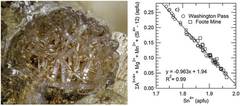Crystal chemistry of brannockite, KLi3Sn2 Si12O30, from a new occurrence in the Golden Horn Batholith, Washington State, USA
| Reviews and Highlights | Quantum Science | Molecular and Soft-matter | Ultrafast Nano-optics and Nanophotonics | Mineralogy and Geochemistry |
|---|
Markus B. Raschke, Evan J.D. Anderson, Julien Allaz, Henrik Friis, Joseph R. Smyth, Rudy Tschernich, and Randy Becker
Eur. J. Minearl 27, 5 (2015).
DOI PDF SI

A second locality of the milarite-group mineral brannockite (ideally KLi3Sn2Si12O30) has been discovered at Liberty Bell/Washington Pass in the peralkaline granite of the Golden Horn Batholith, Okanogan County, Washington, USA as millimeter sized euhedral bladed clear crystals in a single miarolitic cavity. The Washington Pass brannockite shows microscale compositional zoning involving tetravalent A-site Sn4+, Zr4+, Ti4+, and Hf4+ substitution and the coupled substitution A(X4+) + B□ ⇔ A(Fe/Al)3+ + B(Na, K)+. In contrast, brannockite analyzed from the type locality in the late hydrothermal zone of the Li-Sn-rich pegmatite of the Foote Mine, Kings Mountain, North Carolina, USA exhibits near end-member composition with only minor Na+, Al3+, and Ti4+. Single-crystal X-ray diffraction of Washington Pass brannockite confirms the space group P6/mcc with unit-cell parameters a = 10.014(2) Å, c = 10.014(2) Å, and V = 1239.16(8) Å3. Washington Pass brannockite co-exists with its Zr-analogues, both the milarite-group sogdianite and the related tuhualite-group mineral zektzerite. Selected samples of both minerals show Sn as minor element. The sogdianite contains unusually low Na and Ti compared to most other localities and has near end-member composition. The results emphasize the high compatibility of the milarite structure with different heterovalentions, associated with the cation-size dependent coupled distortion of the octahedral A and tetrahedral T2 sites.
